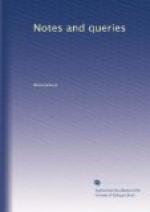“Let * * * Judges, Ministers combine,
And here great Wilkes and Liberty confine.
Yet in each English heart secure their
fame is
In spite of crowded levies at St. J——’s.
Then while in prison Envy dooms their
stay,
Here grateful Britons daily homage pay.”
The inscription upon the tomb of William Allen was visible in 1817, and in addition to the inscription on the north side, which has already been printed in “NOTES AND QUERIES” (Vol. ii., p. 333), was as follows:—
South Side.
“O disembody’d soul! most
rudely driven
From this low orb (our sinful seat) to
Heaven,
While filial piety can please the ear,
Thy name will still occur for ever dear:
This very spot now humaniz’d shall
crave
From all a tear of pity on thy grave.
O flow’r of flow’rs! which
we shall see no more,
No kind returning Spring can thee restore,
Thy loss thy hapless countrymen deplore.
East Side.
“O earth! cover not thou my blood.”—Job. xvi. 18.
West Side.
“Take away the wicked
from before the King, and His throne shall be
established in righteousness.”—Prov.
xxiii. 5.
Fifteen months afterwards the father of William Allen presented a petition to his majesty for vengeance on the murderers of his son.
O. SMITH.
* * * * *
REPLIES TO MINOR QUERIES
Osnaburg Bishopric (Vol. ii. p. 358.).—By the treaty of Osnaburg, in 1624, it was stipulated “that the alternate nomination to the Bishopric of Osnaburg should be in the catholic bishops, and in the protestant branches of the house of Luneburg.” Thus, the Princes Ernest Augustus, the father of George I., Ernest Augustus, brother of the same monarch, and the late Duke of York, became sovereign-bishops of Osnaburg. But by the treaty of Vienna, in 1815, the bishopric became an integral part of the kingdom of Hanover. (Vide Halliday’s House of Guelph, 4to. 1820, pp. 134, 135, 335.)
F.E.
Death of Richard II. (Vol. ii., p. 391.).—Otterburn tells us (pp. 228, 229.) that Richard II.’s death took place at Pontefract Castle, on St. Valentine’s day, and adds, that the body was exposed to public view in all the principal towns through which it passed on the road to London. See also Walsingham (p. 363.):
“Clausitque diem extremum
apud castrum de Pontefracto, die Sancti
Valentini.”
{448} The Keeper of the Wardrobe, moreover, received 100 marks for the conveyance of the king’s body from Pontefract to London. (Issue Rolls, 1 Henry IV.)
It was the belief of many contemporaries—and arguments have been adduced by modern writers in support of the supposition—(see a very interesting treatise on the subject in the second volume of Tytler’s History of Scotland), that Richard II. escaped from his prison, and lived for several years in Stirling Castle. But be that as it may, Froissart, I think, is clearly wrong in stating that he died in the Tower of London.




